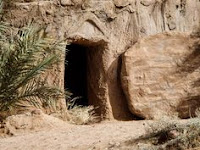It is uncertain how
much time elapsed between Chapters 16 and 17, but as this chapter opens we find
the Philistines gathering for war against Saul and the men of Israel. The
battlefield is described as the Philistines to the north and the Israelites to
the south. Between them was the valley
of Elah.
The Philistines
had a nine and a half foot giant as their champion soldier. He name was Goliath from Gath. His armored
appearance was stunning. “Commanders of opposing armies
in the ancient Near East would occasionally avoid engaging all their forces;
instead, each would select his best fighter to engage in a death match with the
best fighter from the other army.”[1]
The challenge came from this Goliath. ““And the Philistine
said, “I defy the ranks of Israel this day. Give me a man, that we may fight
together.”” (1 Samuel 17:10, ESV). As the incumbent king of Israel it was Saul’s
duty to accept the challenge. Israel and
their king were “dismayed and afraid.”
Who is this Goliath of
Gath? Gath was one of the five Philistine city-states during the Iron Age. It was located
in northeast Philistia.”[2] The Philistines enemies of
the Hebrew people between the time of the conquest until the divided kingdom. By the time Israel had been led out of Egypt,
the Philistines had established themselves as a mighty nation. “When Pharaoh let
the people go, God did not lead them by way of the land of the Philistines,
although that was near. For God said, “Lest the people change their minds when
they see war and return to Egypt.”” (Exodus 13:17, ESV). During the initial conquest of Canaan,
Israel did not fully displace the Philistines (Josh 13:2–3). While the
Philistines declined in power over time, they remained a threat and an enemy
throughout the duration of the divided kingdom.
In addition to noting Goliath’s height the
text offers a detailed description of his armor and weapons. What is occurring here
is best understood through the narrative of the Bible, or Biblical
Theology. This is not just an account of
an ancient battle. This is a chapter in
an ongoing story.
God created mankind to act as His
vice-regents throughout the world displaying His glory and exercising rule on
His behalf. Man sinned. In the Garden,
incarnated as a snake, Satan successfully tempted the first man and woman. God judged their disobedience and He cursed
the snake. “I will put enmity
between you and the woman, and between your offspring and her offspring; he
shall bruise your head, and you shall bruise his heel.”” (Genesis 3:15, ESV).
God caused war to
commence between Satan and the Woman and between Satan’s offspring and her
offspring. For ever after that there were 2 lines of spiritual offspring in the
world: Satan’s and the Woman’s. That
conflict was seen almost immediately between Eve’s sons, Cain and Abel. Abel was killed by the offspring of Satan (Cain). That conflict between ungodly offspring and
godly offspring continued down through history until the Satan’s head was
bruised by The Woman’s Seed.
David as the anointed king
was the godly seed. And as this familiar
story unfolds we will see that the head of the ungodly Philistine will be
bruised – lethally bruised. So as we
approach this story we see far more than a historic battle, we see a cosmic
battle. We see a battle that the
greatest Son of David will forever bring victory. The Seed of the Woman will conquer.
“Whoever makes a practice of sinning is of the devil, for the devil
has been sinning from the beginning. The reason the Son of God appeared was to
destroy the works of the devil.”
(1 John 3:8,
ESV)
[1] Barry, J. D., Mangum, D., Brown, D. R.,
Heiser, M. S., Custis, M., Ritzema, E., … Bomar, D. (2012, 2016). Faithlife Study
Bible (1 Sa 17:4). Bellingham, WA: Lexham Press.


